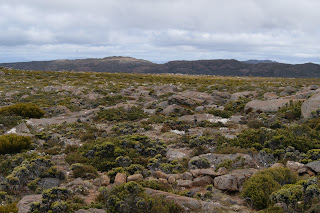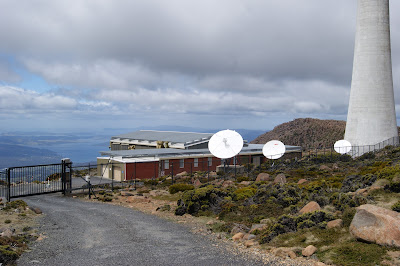It is frequently snow covered, sometimes even in summer and the lower slopes are thickly forested, but criss-crossed by many walking tracks and a few fire trails. There is also a sealed but narrow road to the summit, about 22 kilometres (14 mi) travel from the city. An enclosed lookout near the summit provides spectacular views of the city below and to the east, the Derwent estuary, and also glimpses of the World Heritage Area nearly 100 kilometres (62 mi) to the west.
From Hobart, the most distinctive feature of Mount Wellington is the cliff of dolerite columns known as the Organ Pipes. It has spectacular views and is one of Hobart's biggest tourist destinations
Mount Wellington was originally referred to as Unghbanyahletta (or Ungyhaletta), Poorawetter (or ‘'Pooranetere'’, also Pooranetteri), or Kunanyi to the indigenous people of Tasmania. The Palawa, the surviving descendants of the original indigenous Tasmanians, tend to prefer the latter name. The indigenous population are believed to have arrived in Tasmania approximately 30-40,000 years ago. Their beliefs and traditions, coupled with modern archaeological research, suggest that they may have occupied and utilised the mountain and its surrounding areas for much of the occupation of the island.
The first recorded European in the area Abel Tasman probably did not see the mountain in 1642, as his ship was quite a distance out to sea as he sailed up the South East coast of the island - coming closer in near present day North and Marion Bays.
In 1798 Matthew Flinders and George Bass circumnavigated the island. Whilst they were resting in the area Flinders named the river the Derwent River (the name John Hayes had given only to the upper part of the river), Flinders referred to the mountain as ‘Table Mountain’ (the name given to it by Bond and Bligh - young Matthew Flinders was with them in 1791) for its similarity in appearance to Table Mountain in South Africa. Bruni d'Entrecasteaux's men were the first European to sail up the river and chart it. Later Nicholas Baudin led another French expedition in 1802, and whilst sheltering in the Derwent River (which they referred to as ‘River du Nord’ - the name d'Entrecasteaux had given to it) Baudin also referred to the mountain as ‘Montagne du Plateau’ (also named by d'Entrecasteaux). However, the British first settled in the Hobart area in 1804, resulting in Flinders’ name of ‘Table Mountain’ becoming more popular.
Table Mountain remained its common name until in 1832 it was decided to rename the mountain in honour of the Duke of Wellington who, with Gebhard Leberecht von Blücher finally defeated Napoleon at the Battle of Waterloo in present-day Belgium on 18 June 1815.
Throughout the 19th and into the 20th centuries, the Mountain was a popular day-resort for residents of Hobart. To that end, many excursion huts were built over the lower slopes of the mountain. However, none of these early huts survive as they were all destroyed during the disastrous bushfires of 1967, though modern huts are open to the public at the Springs, the Pinnacle, the Chalet - a picnic spot about halfway between the Springs and the Pinnacle - and elsewhere. Sadly, many of the more remote huts have suffered from vandalism, and some are in virtually derelict condition.
The Mountain has played host to some notorious characters over time, especially the bushranger 'Rocky' Whelan, who murdered several bushwalkers through the early 19th century. The cave where he lived is known appropriately as 'Rocky Whelan's Cave', and is an easy walk from the Springs.
The road to the summit was constructed in the early 1930s as a relief scheme for the unemployed, an idea initiated by Albert Ogilvie, the Premier of Tasmania of the day. While the road is officially known as the Pinnacle Drive, it was, for some time, also widely known among residents of Hobart as 'Ogilvie's Scar' because at the time it was constructed 'the Mountain' was heavily logged and almost bare, and the road was an all-too-obvious scar across the already denuded mountain. Today the trees have grown again but the 'scar' most people see today is not actually the road but a line of large rocks with no trees 50–100 m above the road, provided as an easement for power lines. The road itself was opened in August 1937, after nearly two years of work, by Governor Sir Ernest Clark.
Halfway up this road is a picnic area called "The Springs", near the site of a chalet/health spa that was destroyed by bushfire in 1967.
Mount Wellington was selected by many broadcasters as the site of broadcast radio and television transmitters because it provides line-of-sight transmission to a much larger area of Hobart and surrounding districts than any other point in the region. The first television stations to transmit from there were TVT-6 (now WIN Television) and ABT-2 (the ABC) in 1960. The mountain has two main transmission towers located at its pinnacle.
One is the concrete and steel constructed Broadcast Australia Tower (sometimes referred to as the NTA Tower) and one owned by WIN television which is of steel construction. The NTA tower broadcasts all of Hobart's high power FM radio stations, and ABC, SBS and Southern Cross analogue Television services, plus the digital services for ABC and SBS. The NTA tower also has a small accommodation area at its base with kitchen and workshop area. The WIN TV tower has TVT6's analogue TV services transmitted from it as well as the digital services from Southern Cross, Win TV, and Tasmanian Digital Television. The site also contains a small kitchen area and contains some data links from local Hobart businesses.
The mountain significantly influences Hobart's weather, and intending visitors to the summit are advised to dress warmly against the often icy winds at the summit, which have been recorded at sustained speeds of over 157 km/h (97 mph), with rare gusts of up to 200 km/h (124 mph). In the winter it often snows and the mountain is often snowcapped. Lighter snowfalls in spring, summer and autumn are also common. A day on the summit can consist of clear sunny skies, then rain, then snow, then icy winds and then clear again.
The first weather station was set up on Mount Wellington in 1895 by Clement Lindley Wragge. - Wikipedia
The trip to the pinnicle of Mt Wellington is a very easy drive along the pinnicle road. You can view the varying landscapes as you go further up the mountain, from wooded forest areas to open rocky plateaus. Also fantastic views across Hobart and suburbs, further up the Derwent Valley, across towards Port Arthur & Bruny Island and westerly towards the world heritage areas. Plenty of opportunities for avid photographers. I hope you enjoy some of my photographs on this post.










